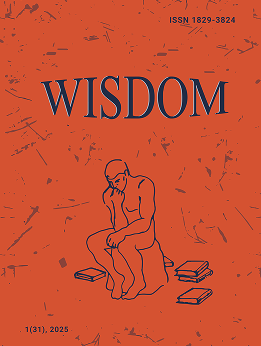Nonverbal communication means in the UK parliamentary debates
DOI:
https://doi.org/10.24234/wisdom.v17i1.461Keywords:
nonverbal communication, political discourse, parliamentary debates, proxemics,, oculesics,, tacesics, national character, traditionalityAbstract
This article focuses on the proxemics, oculesics and tacesics as nonverbal communication peculiarities in the UK parliamentary debates within the scope of parliamentary discoursology as a new branch of political discourse studies. It deals with studying of metonomy-based language representations of space used to name the MPs in the UK parliamentary debates. Here the visual characteristics and behavioral patterns influencing the role and participation of MPs in the debates are highlighted. The paper determines cognitive background and extralinguistic factors influencing the usage of naming models and colour determination of MPs in the parliamentary debates. Such debates represent the events regardless the party that gains majority in the UK parliament in the post-Thatcher period. It is concluded that nonverbal have become an inseparable part of parliamentary communication, serving as a special communicative code used by the MPs. The results stipulate further modelling of the parliamentary debates to build their interactive and cognitive models for better insight into the British political life and the British national character. The received knowledge is of particular importance for teaching country studies, history of the UK, political science and theory of speech communication.
Downloads
References
Brown, A., & Starkey, K. (1994). The Effect of Organizational Culture on Communication and Information .Journal of Management Studies, 31, 807-828.
Burke, K. (1967). A Grammar of Motives. Berkeley, CA: University of California Press.
Cambridge Dictionary. (n.d.). Retrieved 18 November, 2020 from: https://dictionary.cambridge.org.
Clark, M., & Paivio, A. (1991). Dual Coding Theory and Education. Educational Psychology Review, 3, 149-210.
Combs, J. (1981). Process Approach. Handbook of Political Communication. London: Sage Publications.
Commons Chamber. (n.d.). Retrieved 15 November, 2020 from: https://www.parliament.uk/about/living-heritage/building/palace/architecture/palace-s-interiors/commons-chamber/.
Conduct in the Chamber. (n.d.). Retrieved 15 November, 2020 from: https://publications.parliament.uk/pa/cm199798/cmselect/cmmodern/600iv/md0404.htm.
Denton, R. Jr., & Kuypers, J. A. (2008). Politics and Communication in America. Campaigns, Media and Governing in the 21 Century. Long Grove, Illinois: Waveland Press.
Ekman, P., &Friesen W. V. (1975). Universalsand Cultural Differencesin Facial Expressionsof Emotion. In Cole J. (Ed.), Nebraska Symposium on Motivation. Vol. XIX.(pp. 207-282). Lincoln: University of Nebraska Press.
Hacker, K. L. (1996). Political Linguistic Discourse Analysis. In M. E. Stuckey (Ed.), The Theory and Practice of Political Communication Research. (pp. 28-55). New York: State University of NewYork Press.
Hall, E. T., & Hall, M. R. (1990). Understanding Cultural differences: German, French, and Americans. Yarmouth, ME: Intercultural Press.
Hargie, O. D. W. (1997). The Handbook of Communication Skills. London and New York: Routledge.
Heath, R. L., & Bryant, J. (1992). Human Communication Theory and Research: Concepts, Contexts and Challenges. Lawrence Erlbaum, Hillsdale, NJ: Lawrence Erlbaum Associates.
House of Commons Green. (2010). Retrieved 17 November, 2020 from: http://www.parliament.uk/documents/commons-information-office/g10.pdf.
House of Commons Procedure and Practice. (2009). (2nded.). Retrieved 15 November, 2020 from: http://www.parl.gc.ca/procedure-book-livre/document.aspx?sbdid=1b08a55c-743c-47db-92e0898d41340504&sbpidx=4.
Lajul, W. (2020).A Critical Analysis of Political Philosophy in African Political Discourses. Art Human Open Access Journal, 4(5), 176-185.
Lakoff, G., & Johnson, M. (2003). Metaphors We Live By. London: UniversityofChicagoPress.
Mandal, F. B. (2014). Nonverbal Communication In Humans. Journal of Human Behaviour in the Social Environment, 24(4), 417-421.
Matsumoto, D. (2006). Cultural Influenceson Facial Expression of Emotion. Southern Communication Journal, 56, 128-137.
McNeill, D. (2012). How Language Began: Gesture and Speech in Human Evolution. University of Chicago.
Oxford Dictionaries. (n.d.). Retrieved 18 November, 2020 from:http://oxforddictionaries.com/.
Pease, A., & Pease, B. (2004).The Definitive Book of Body Language.Pease International.
UK Parliament. (n.d.) Retrieved 15 November, 2020 from: https://www.parliament.uk.
Woods, N. (2006). Describing Discourse: A Practical Guide to Discourse Analysis. Trans-Atlantic Publications.
Downloads
Published
How to Cite
Issue
Section
License
Copyright (c) 2021 Author and scientific journal WISDOM

This work is licensed under a Creative Commons Attribution-NonCommercial 4.0 International License.
Creative Commons Attribution-Non-Commercial (CC BY-NC). CC BY-NC allows users to copy and distribute the article, provided this is not done for commercial purposes. The users may adapt – remix, transform, and build upon the material giving appropriate credit, and providing a link to the license. The full details of the license are available at https://creativecommons.org/licenses/by-nc/4.0/.















